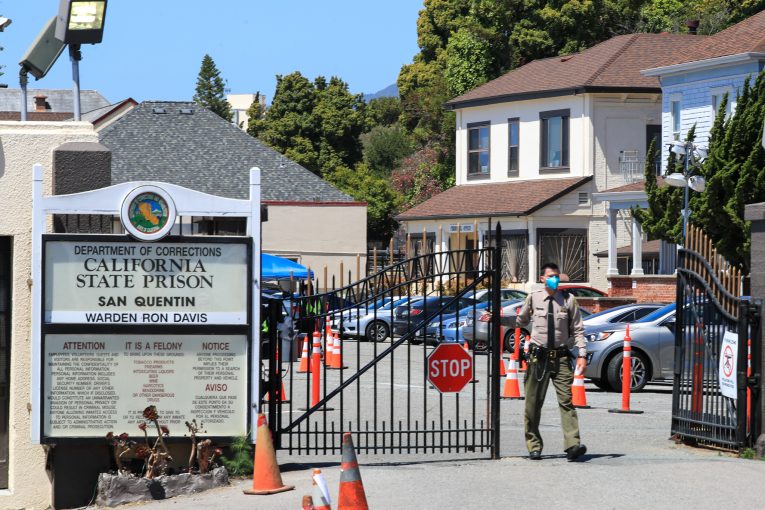
By Kevin D. Sawyer
Kevin D. Sawyer is the associate editor for San Quentin News and a member of the Society of the Professional Journalists (SPJ) whose work has appeared in the Guardian, San Francisco Chronicle and numerous other publications.
Prisoners at San Quentin State Prison have been on “modified program” or what some call a virtual lockdown, due to COVID, for more than a month.
Less that two weeks into another in a series of COVID lockdowns at the 170-year-old prison, James King of the Ella Baker Center for Human Rights reported nearly 300 prisoners and about 100 staff were either infected or tested positive for the virus.
“The numbers are probably higher,” King said during a January broadcast on the Bay Area radio station KPFA (94.1 FM). It was reported that some 5,500 prisoners were infected statewide and the combined number of staff and inmate infections were estimated to be about 10,000. That was nearly three weeks ago, and since then prisoners have ot been provided with meaningful updates or new statistics.
“You can’t say anything or you’ll lose your cell and lose your shit,” a prisoner was heard speaking inside San Quentin’s West Block. He was making reference to the prison’s practice of quarantining prisoners outside of their assigned cells, and later misplacing, loosing, or allowing other inmates to steal their personal property. More than a few were reluctant to make comments on the record.
Prisoners do not like the idea of being moved to quarantine in the prison’s chapel or gymnasium to sleep on a cot near others who are infected or sick. They run the risk of losing their personal property because they are only allowed to take a few items with them from their cell. Because most are vaccinated they say it is preferable to quarantine or recover from any illness in a cell. The prison’s Adjustment Center (or the hole) is the only lockup facility with solid steel doors. All other cells have open bars, and the five dormitory units are a wide open space.
State mishandling of the 2020 COVID-19 outbreak at San Quentin, and later court decisions to not grant prisoners relief from “deliberate indifference” of prison officials has left many prisoners numb and speechless.
“I’m mostly frustrated that the officers have not been mandated to be vaccinated, or forced to at San Quentin,” said Kevin Flanagan, 38, who lives in the prison’s West Block.
According to a mid-January Daily Program Status Report (DPSR) at the prison, there was supposed to be “controlled feeding in the dining room.” Feedning, however, was done one tier at a time. There are five tiers in West Block, and each has an original design capacity to house 90 men. Because two men are placed in each cell there are nearly 180 men housed on each tier. This leaves little room for controlled feeding or social distancing once all cells are open and the men return from their meals.
“The California Department of Corrections and Rehabilitation (CDCR) implemented statewide program modification and directed all institutions to develop local modifications to reduce staff and inmate exposure to COVID-19.” the DPSR reads in part, adding, “quarantine units will follow general COVID precautions…”
San Quentin’s status of each affected housing unit on the January DPSR reads:
- 1/13/22 Alpine (section) on medical quarantine
- 1/14/22 East Block on medical quarantine
- 1/15/22 North Block on medical quarantine
- 1/16/22 CTC/4th Floor CHSB (the prison hospital) is on medical quarantine
- 1/17/22 West Block is on medical quarantine
- 1/17/22 Dorm five is moved to quarantine status
- 1/17/22 Dorm two, three, four and five are now on quarantine orders
These quarantined housing units created a shortage of inmate workers, which is what the CDCR depends on to help operate its 35 state prisons.
“Anyone who wants to volunteer to work in the kitchen in the A.M., come to the desk,” a correctional officer said over the West Block PA system. There was no information or indication how the prison was to screen and food-clear “volunteers” to handle food in the kitchen. In years past, inmates had to be screened for other infectious diseases such as HIV/AIDS and Hepatitis.
At breakfast the following morning, a correctional officer was collecting dirty trays from prisoners to take to the scullery in the kitchen to be washed by staff or inmates. That evening, a teacher who works in San Quentin’s education department was seen in the West Block dining hall kitchen area. He was wearing gloves, standing, as if he was prepared to work.
Prisoners have been watching news reports on television that discussed the COVID surge in the United States, citing 1,800 to 2,000 deaths per day from the disease, and more than 20,000 patients admitted to hospitals each day. They’ve watched as the country marked a grim milestone: 900,000 deaths since the start of the pandemic.
Prisoners at San Quentin have been also questioning the other surge at the prison in recent months. That is the surge of other prisoners arriving to push the prison population further beyond its design capacity.
“Any COVID symptoms?” nurses have been routinely asking as they walk by cells in the West Block. Only once have they asked to check everyone’s vital signs such as temperature or blood oxygen levels.
An inmate in a distant cell could be heard explaining to a nurse that other inmates “will not provide accurate information” about the state of their health condition. He said some inmates are really sick around him so he wanted to move. It’s a shell game where moves are ostensibly done to keep everyone safe.
“If they don’t want to tell the truth– we’ve done our part,” the nurse said as she moved down the tier, asking about symptoms.